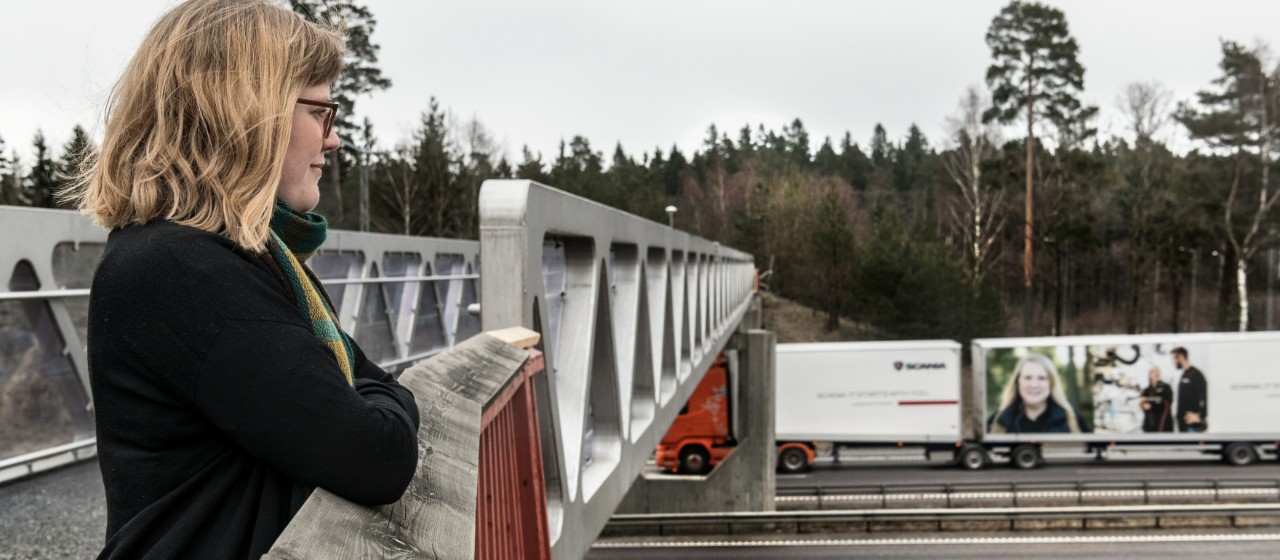
She designs future vehicles
31 MAY 2018
Self-driving vehicles may eventually give rise to safer road conditions, more efficient handling of goods and improved traffic flow. Marie Bemler, an industrial PhD student at Scania, is among the people who will make sure we get there.
There is a change underway in the transport sector. With digitisation and autonomous vehicles, technological development is moving extremely fast, while ever more people are realising that the entire industry must get on board and contribute to reducing global carbon dioxide emissions.
Marie Bemler, an industrial PhD student at Scania, is heavily involved in this shift, her focus being on intelligent transport systems and digitisation. Previously, she worked on developing the radar that is currently fitted in numerous Scania trucks. Sensors of this kind play a key role in the increasingly advanced driver support systems behind various kinds of self-driving vehicles.
On the front line
“It feels like a real treat to be involved in everything that is happening at the moment,” she says. “I really am on the front line of development.”
However, it wasn’t a given that trucks, buses and engines would be at the heart of Bemler’s career choice in life. Admittedly she has a Master of Science in Engineering, but her education was interdisciplinary, including elements of the humanities and social sciences as complements to the technical aspects of her studies.
“I don’t actually have a passion for engines and heavy vehicles as such; I’m primarily interested in how technology works together with infrastructure.”
This is precisely why she became interested in Scania, and why she applied to Scania Student Intro: a programme for students who are close to graduation that gives them an opportunity to work at Scania during the summer and do their thesis there.
Developing advanced driver support systems
In her first few years at Scania, Bemler worked with the testing of software for Scania’s gearboxes. However, when she returned to work after her first period of parental leave, she got the opportunity to join a group that develops automatic emergency brakes and other advanced driver support systems.
She is now heavily involved in the development of self-driving vehicles and is embarking on a research project involving several of Sweden’s universities and large companies, which aims to identify solutions featuring the autonomous technology of the future.
According to Bemler, technology companies such as Scania have come a long way in developing vehicles’ own technical systems.
“Scania’s responsibility as a vehicle developer is to show what the technology can actually already accomplish today, such as when we ‘let go of the steering wheel’ and allow a self-driving truck to drive around on our test track.”
The challenge now is to get all the other stakeholders in society involved in order to create the infrastructure of the future, with wirelessly connected heavy vehicles.
A big challenge
“As a technology company, we are used to managing technological development processes, but now it is also important to show our customers, legislators and society a vision of what automation means and what we should do to develop standards and business models that will help make the vision a reality. It is a big challenge, but at least everyone has the same challenge, including the EU, the UN and individual countries.”
In your opinion, what constitutes “the perfect autonomous solution”?
“If we do this right, we can achieve better cargo handling and passenger transport flows by combining digitisation and autonomous vehicles. This will allow us to maximise use of each transport and reduce total fuel consumption, while also optimising utilisation of the road infrastructure. Automation can also help reduce the number of traffic accidents in the world.”
Do you think there are any dangers involved in self-driving technology?
“Yes, most certainly, but there are dangers involved in all technology, and we do not have a perfect system today either. Every day, 3,000 people die on roads around the world. I am convinced that we can reduce that number significantly with the help of technology. However, a lot of development and testing of the software and sensors will be required in order to minimise the risk of accidents associated with each individual decision that an automatic vehicle will need to make while driving.”